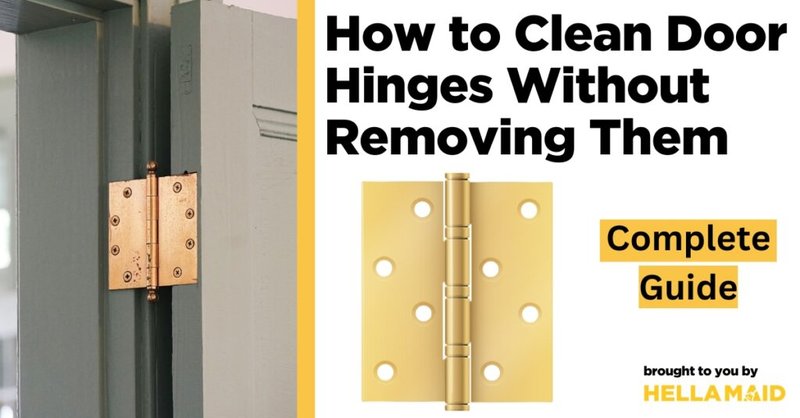
When it comes to door hinges, think of them as the joints in your body. Just like how your joints need a little oil to move freely, hinges benefit from a bit of lubrication to function smoothly. You might have a door that is used frequently, like the one leading to your living room, or one that’s a bit of a loner, like that seldom-used bathroom door. Regardless of its status, keeping all your door hinges in good shape can make a big difference in your home.
Let’s dive into the world of door hinges and learn the step-by-step process of lubricating them without the hassle of taking the door off its frame.
Why Lubricate Door Hinges?
You might be asking, “Why is this even important?” Well, consider the daily wear and tear on your door hinges. Every time you open and close a door, friction builds up. This can lead to corrosion, squeaking noises, or even the hinge getting stuck altogether. Regular lubrication helps to:
- Reduce Noise: Squeaky hinges can be annoying. A little oil can eliminate that sound instantly.
- Prevent Rust: Moisture can cause metal to rust, leading to degradation. Lubricating creates a barrier against moisture.
- Extend Lifespan: Proper maintenance means your hinges will last longer, and you’ll save money on replacements.
So, lubricating your door hinges isn’t just about keeping them quiet; it’s about preserving their functionality and your sanity!
Gather Your Supplies
Before you start, let’s make sure you have everything you need. Here’s a quick list of supplies:
- Lubricant: Choose a suitable lubricant like silicone spray, WD-40, or even a light machine oil.
- Cleaning Cloth: A rag or paper towel will help clean away any dirt and old grease.
- Applicator: This could be a straw (like the one from a spray can), a brush, or even your fingers if you’re careful!
You might be wondering: “Can I use cooking oil?” While it might work in a pinch, it can become sticky over time, attracting more dirt. Stick with a product designed for hinges for the best results.
Step-by-Step: How to Lubricate Door Hinges
Now that you have your supplies, let’s get into the nitty-gritty of lubricating your hinges without removing the door. Follow these steps closely for the best outcome.
Step 1: Inspect the Hinges
Take a close look at your door hinges. Are they rusty or covered in dirt? If you see any signs of corrosion or grime, it’s essential to clean them first. Use a cleaning cloth to wipe away dust and grease, exposing the metal underneath.
Step 2: Apply the Lubricant
Here’s where the magic happens. Spray or apply your chosen lubricant directly onto the hinge. If you’re using WD-40 or similar, aim for the pin and the places where the hinge pivots. If your hinges are particularly dirty, you might want to use a small brush to ensure even coverage.
Step 3: Move the Door
After applying the lubricant, gently open and close the door several times. This motion helps the lubricant reach all parts of the hinge, ensuring a smooth operation. You should notice the creaking sounds begin to fade away.
Step 4: Wipe Away Excess
After you’ve worked the lubricant into the hinge, it’s a good idea to wipe away any excess with your cleaning cloth. This prevents dirt from sticking in the future and keeps your door looking clean.
Choosing the Right Lubricant
Not all lubricants are created equal. Here’s a quick comparison of popular options:
| Type | Pros | Cons |
|---|---|---|
| WD-40 | Great for rust, multipurpose, easy to apply. | Can attract dirt over time. |
| Silicone Spray | Resists moisture, leaves a clean finish. | Can be slippery if over-applied. |
| Machine Oil | Long-lasting, effective for metal parts. | Can be messy to apply. |
The choice really depends on your needs and preferences. No matter what you choose, ensure it’s suitable for metal surfaces for best results.
Common Problems and Troubleshooting
Even with the best intentions, you might run into a few hiccups. Here are some common issues you could face and how to resolve them:
– Squeaking Persists: If you still hear squeaks after lubrication, it might be time to check if the hinge needs replacement or if dirt is gunking it up.
– Lubricant Doesn’t Stick: If your lubricant isn’t adhering well, consider using a thicker oil or applying additional coats.
– Stuck Door: If the door won’t budge despite lubrication, there may be a deeper issue, like misalignment. You might need to adjust the hinges or consult a professional.
When to Seek Professional Help
Sometimes, DIY methods just aren’t enough. If you notice significant rust, damage, or misalignment, it’s wise to call in a professional. They can assess the situation and determine if it’s time to replace the hinge or repair the door.
Final Thoughts
Lubricating door hinges might seem like a small task, but it can have a big impact on your home’s comfort and functionality. Regular maintenance can prevent those annoying squeaks and ensure your doors open smoothly every time. With just a few simple steps and the right supplies, you can keep your door hinges in great shape without any need for heavy lifting. So grab your lubricant of choice and let those doors swing freely!
